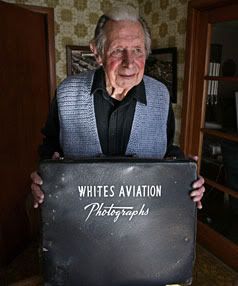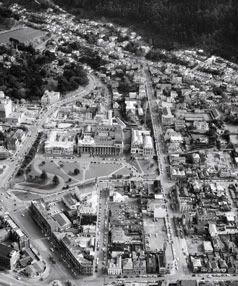Kiwithrottlejockey
Admin Staff
XNC2 GOD

Posts: 32251
Having fun in the hills!
|
 |
« on: October 25, 2009, 02:29:00 pm » |
|
Picture perfectThey were the Google Earth of their day — photographers who took to the air in Tiger Moths, capturing New Zealand's pristine landscapes and growing cities as far back as the 1930s. Kim Knight talks to a living legend from Whites Aviation.By KIM KNIGHT - Sunday Star Times | Sunday, 25 October 2009  BOX OF TRICKS: Clyde “Snow” Stewart, retired aviation photographer (left). — LAWRENCE SMITH. BOX OF TRICKS: Clyde “Snow” Stewart, retired aviation photographer (left). — LAWRENCE SMITH.
BUSTLING METROPOLIS: Downtown Wellington pre-Beehive in 1958 (right). — WHITES AVIATION.IT WAS a New Zealand rarely seen.
There's Kerikeri in 1938, with its corncob-neat rows of newly planted oranges; Auckland's harbour bridge before the central span was attached; Lake Te Anau, in the mid-1950s, bereft of today's top-dollar subdivisions.
These are just some of the historic aerial photographs reproduced in the book Whites Aviation. Launched on Friday, it contains 200-plus images from the 1930s to the 1970s, selected from more than 80,000 negatives and 50,000 prints gifted two years ago to the Alexander Turnbull Library.
Aucklander Leo White took to the skies just two decades after the Wright brothers' first flight — a young man with glass plates in his cameras, photographing the country from the air.
By the late 1930s, White, whose son and grandson would go on to become two of the country's best known newspaper photographers, had joined forces with cinematographer Frank Stewart. Post-World War II, and White was working with Stewart's son Clyde.
Clyde "Snow" Stewart is 87 now. He took over the firm after Leo's death in 1922 and ran it until his retirement in 1982 — a living link to the company whose work still graces boardrooms and farmhouse kitchens.
Last week, Snow sat at a wooden kitchen table in Auckland's Cox's Bay, thumbing through a box of photographs. He can no longer read his carefully inked captions – macular degeneration began stealing his eyesight five years ago.
"I haven't taken any photographs for a while," he says. "I'm overshadowed by my family who bang them off, one after another."
He is pleased, he says, with the new book. "It had always been my anguish that somehow or other the collection would be broken up and dispensed or dispersed."
Press releases for the book call Whites Aviation "the Google Earth of its day". Snow says immediately after World War II, people were starved of pictures. Planes had been grounded and photographic supplies scarce.
"Leo and I, in the early days, hit upon the idea of photography as a means of advertising a target, be it a city or a country village, and putting it in relation to what was the best feature adjacent to it — the Southern Alps against a picture of Westport, or something like that."
Businesses bought the work for their boardrooms; landholders requested pictures of their farms. Aerial photography, says Snow, was popular because it let people "find their way around".
"A map is a series of lines and descriptions and topographical features. But a photograph leads you. You can follow the trail."SNOW'S FIRST photograph was of a rabbit. A family pet, back in the day when the family moved — a lot. "Like most families during the Depression, we had quite a few shifts. One jump ahead of the bailiff."
He thought he might be an engineer, and in his retirement, became a cabinet maker. But his first job, aged 13, was working for his Dad and Leo, building picture frames and processing photographs. "We used to experiment in the bathroom. Mother had to clean up after us. There were all sorts of stains and surprises."
And magic. That moment, when sensitised paper was exposed to light, "and out of nothing, you got a picture".
Both Leo and Snow would work as war time photographers in the Pacific. But, before their respective tours, they photographed the Queen Street victory parade in Auckland for the crew of the HMS Achilles who fought World War II's first major naval battle at the River Plate.
Leo and Snow's dad shot the returning ship from the air. Snow, left behind in the office, climbed on to a nearby roof.
"I could see them coming up the street. All this confetti was coming down, and just at that time I pressed the trigger and I knew it was at the right time, because by the time I had taken the slide out and turned it around, the parade was going past me."
The Queen Street march hangs on his dining room wall — his first published photograph, in New Zealand Free Lance.
"It was the only victory we'd had up to that date and that's why there was so much jubilation. I've never seen a parade in Queen Street like it, before or since. But it was a victory. And by God we were starved for victory in those days."
Stationed in Bougainville, a few years later, Snow would photograph the Japanese surrender to the Allied forces, "which was a marvellous thing". Back home, post-war, Whites Aviation turned its attention to New Zealand. In 1952, Leo shot the images for Whites Pictorial Reference of New Zealand. The publication was updated in 1960, when Snow joined him in the air with his home-made "Big Bertha" camera, that used a Japanese lens he acquired in Rabaul, during the war.
"It wasn't actually stolen," he recalls in the introduction to Whites Aviation. "It had been left lying around."
Bertha took glass plates held in a 12-pack magazine. "You took your picture and pulled the negative through into a little leather bag ... every 12th picture that was taken, you had to replace the magazine."
There wasn't much room in the Tiger Moth plane. "You were limited to about four magazines for the day's flying."
The resulting photographs show a New Zealand still very much in progress. An operational Blackball Mine. Manukau City as a patch of bare land. Arthur's Pass minus the viaduct bridge. Stretches of empty coastline that would make today's property developers weep.
All of the images are in black and white. Hand-tinting was preferable to colour film, says Snow, which didn't provide enough contrast. Photographers made notes of client's red roofs and cream walls. "I've got to be honest," admits Snow, "we didn't always get it right!"
While the aerial work was the firm's bread and butter, he says it was the events photography he enjoyed most.
Rugby matches would be shot soon after the 3pm kick-off and the first prints rushed into Kodak's window and the Auckland Star in time for the last edition. In the days before Sky Television and cellphone-sent images, Snow remembers crowds would gather around the Kodak shop at mealtime to see pictures from the game.
When Auckland's harbour bridge was pieced together, the company carefully planned its flight path.
"You're in the air, looking into the distance and all of a sudden, it's becoming closer and closer... by the time you got to it, you'd already photographed it once or twice in your mind.
"Every picture had to tell a story."• “Whites Aviation”, Alexander Turnbull Library, Godwit/Random House, $60.http://www.stuff.co.nz/sunday-star-times/features/2995931/Picture-perfect
|